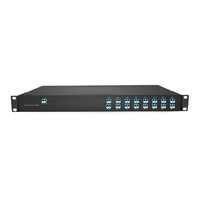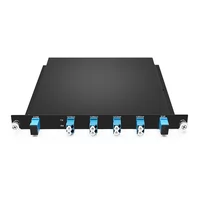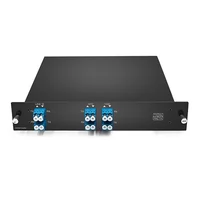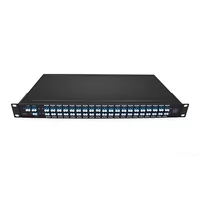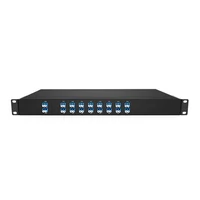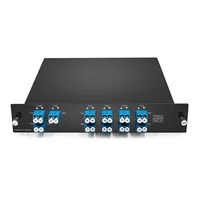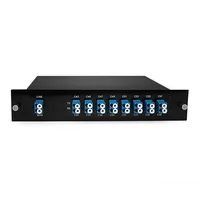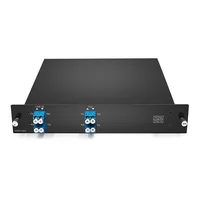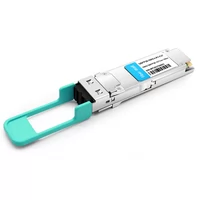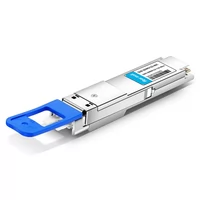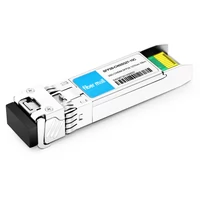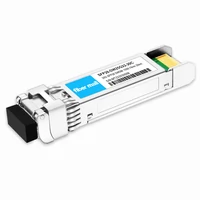Optical Add/Drop Multiplexer referred to as OADM, is one of the key components of wavelength division multiplexing (WDM) optical networks. Its function is to selectively receive and transmit certain wavelength channels from the transmission optical path without affecting the transmission of other wavelength channels.

OADM equipment is used in both long-haul trunk lines and metropolitan area networks.
In trunk applications, OADM is the preferred device for intermediate nodes with upper and lower traffic.
The main battlefield of OADM applications is the metropolitan area network, which can be flexible in networking, easy to upgrade and scale up. It is an ideal multi-service transmission platform for metropolitan area network applications.
The OADM allows different wavelength signals of different optical networks to be inserted and multiplexed at different locations. Optical cross-connect (OXC) devices allow different networks to be dynamically combined, allocate wavelength resources on-demand, and implement a wider network interconnection. OADM and optical cross-connect (OXC) devices only send information that needs to be downloaded at the node to the processing device (including ATM switches, SDH switches, and IP routers), the information needn`t processed by the node directly pass through the optical channel, thereby greatly improves the efficiency of the node processing information, and the service processing node must deal with all the arriving IP packets.
Optical Code Division Multiple Access (OCDMA) technology is a good all-optical network networking technology, which avoids the “electronic bottleneck” effect of communication equipment and the queuing delay of network protocols, enabling high-speed information transmission and fast-step asynchronous information access.
With all-optical backbone network composed of OCDMA technology, the information can be carried out either in the node or at any place where the fiber line passes, without affecting the normal transmission of other users on the fiber line. It overcomes the limitation that the upper and lower routes of information in the traditional network can only be carried out in the nodes. The optical up and down roads can be performed at any time between two optical cross-connect nodes or optical switching nodes as needed.
Coarse Wavelength Division Multiplexing (CWDM) and Dense Wavelength Division Multiplexing (DWDM)
The two key WDM technologies are coarse wavelength division multiplexing (CWDM), and dense wavelength division multiplexing (DWDM).

CWDM systems typically provide 8 wavelengths, separated by 20nm, from 1470nm to 1610nm. In order to increase the number of wavelengths, one can also use the 1310nm window so the CWDM channels can be increased to 16. The number of channels is fewer than in DWDM but more than in standard WDM.
DWDM packing WDM channels denser than in CWDM system, it can go up to 80 or even 160 channels / wavelengths, with no more than 0.4nm spacing, roughly over the C-band range of wavelengths. It supports much more wavelengths than that of CWDM MUX DEMUX. DWDM’s tighter wavelength spacing fits more channels onto a single fiber, but cost more to implement and operate.
CWDM spectrum supports data transport rates of up to 4.25Gbps while DWDM is utilized more for large capacity data transport needs of up to 100Gbps. By mapping DWDM channels within the CWDM wavelength spectrum, much higher data transport capacity on the same fiber optic cable can be achieved without any need for changing the existing fiber infrastructure between the network sites. By utilizing CWDM and DWDM network systems or the mixture of them, carriers and enterprisers are able to transport service from 2Mbps up to 200Gbps of data.
The features of OADM:
1. Low Insertion Loss
2. High stability and reliability
3. High channel Isolation
The Application of OADM:
1.DWDM Network
2.Wavelength Routing
3.Fiber Optic Amplifier
4.CATV Fiberoptic System
Case of OADM: wave division equipment data service transmission network solution
In the construction of the metropolitan/local network, an important backbone node is usually selected in the core layer of the network to construct an OADM ring network. As the core network at the highest level, it is a comprehensive optical transmission platform for voice, data and other services, and plays a vital role in the transmission, scheduling and convergence of services.


Table of Contents
ToggleRelated Products:
-
 Passive CWDM Double Fiber Mux & Demux Module 16 CH (1310-1610nm) 1U Rack
$570.00
Passive CWDM Double Fiber Mux & Demux Module 16 CH (1310-1610nm) 1U Rack
$570.00
-
 CWDM MUX 4CH 8 Wavelengths (TX: 1470/1490/1510/1530nm RX: 1550/1570/1590/1610nm) with Express Port LC/UPC Single Fiber LGX BOX
$150.00
CWDM MUX 4CH 8 Wavelengths (TX: 1470/1490/1510/1530nm RX: 1550/1570/1590/1610nm) with Express Port LC/UPC Single Fiber LGX BOX
$150.00
-
 Passive CWDM Double Fiber 4 Channels OADM LGX BOX
$250.00
Passive CWDM Double Fiber 4 Channels OADM LGX BOX
$250.00
-
 Low IL 3.5dB DWDM MUX DEMUX 40CH (C21-C60) LC/UPC Dual Fiber 1U Rack
$1200.00
Low IL 3.5dB DWDM MUX DEMUX 40CH (C21-C60) LC/UPC Dual Fiber 1U Rack
$1200.00
-
 DWDM MUX DEMUX 16CH (C21-C36) with Monitor Port LC/UPC Dual Fiber 1U Rack
$800.00
DWDM MUX DEMUX 16CH (C21-C36) with Monitor Port LC/UPC Dual Fiber 1U Rack
$800.00
-
 DWDM MUX DEMUX 8CH (C21-C28) with Express Port LC/UPC Dual Fiber LGX BOX
$500.00
DWDM MUX DEMUX 8CH (C21-C28) with Express Port LC/UPC Dual Fiber LGX BOX
$500.00
-
 DWDM MUX 8CH 16 Wavlengths (TX: C43/C45/C47/C49/C51/C53/C55/C57 RX: C44/C46/C48/C50/C52/C54/C56/C58) with MON Port LC/UPC Single Fiber LGX BOX
$450.00
DWDM MUX 8CH 16 Wavlengths (TX: C43/C45/C47/C49/C51/C53/C55/C57 RX: C44/C46/C48/C50/C52/C54/C56/C58) with MON Port LC/UPC Single Fiber LGX BOX
$450.00
-
 Passive DWDM Double Fiber OADM Module 2 DWDM Wavelengths (100GHz Spacing) LGX BOX
$200.00
Passive DWDM Double Fiber OADM Module 2 DWDM Wavelengths (100GHz Spacing) LGX BOX
$200.00
-
 QSFP28-100G-LR1-C27 100G CWDM QSFP28 Single Lambda LR 1271nm 10km LC SMF with FEC DDM Optical Transceiver
$600.00
QSFP28-100G-LR1-C27 100G CWDM QSFP28 Single Lambda LR 1271nm 10km LC SMF with FEC DDM Optical Transceiver
$600.00
-
 Q28-2DW2122-80C 100G DWDM QSFP28 PAM4 80km C21 C22 100GHz CS DDM Optical Transceiver
$1600.00
Q28-2DW2122-80C 100G DWDM QSFP28 PAM4 80km C21 C22 100GHz CS DDM Optical Transceiver
$1600.00
-
 SFP28-CW25G27-10C 25G CWDM SFP28 1270nm 10km LC SMF DDM Transceiver Module
$50.00
SFP28-CW25G27-10C 25G CWDM SFP28 1270nm 10km LC SMF DDM Transceiver Module
$50.00
-
 SFP28-DW25G22-20C 25G SFP28 DWDM C22 100GHz 20KM 1559.79nm LC SMF DDM Transceiver Module
$600.00
SFP28-DW25G22-20C 25G SFP28 DWDM C22 100GHz 20KM 1559.79nm LC SMF DDM Transceiver Module
$600.00

